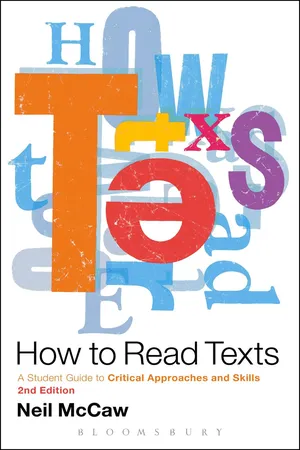
- 192 pages
- English
- PDF
- Available on iOS & Android
About this book
Now in its second edition, How to Read Texts introduces students to key critical approaches to literary texts and offers a practical introduction for students developing their own critical and close-reading skills. Written in a lively, jargon-free style, it explains critical concepts, approaches and ideas including: - Debates around critical theory
- The role of history and context
- The links between creativity and criticism
- The relationship between author, reader and text. The new edition now includes guidance on analysing a range of multi-media texts, including film and online media as well as the purely literary. In addition to new practical examples, readings, exercises and 'checkpoints' that help students to build confidence in their own critical readings of both primary and secondary texts, the book now also offers guidance on writing fully-formed critical essays and tips for independent research. Comprehensively updated and revised throughout, How to Read Texts is an indispensible guide for students making the transition to university study.
Frequently asked questions
- Essential is ideal for learners and professionals who enjoy exploring a wide range of subjects. Access the Essential Library with 800,000+ trusted titles and best-sellers across business, personal growth, and the humanities. Includes unlimited reading time and Standard Read Aloud voice.
- Complete: Perfect for advanced learners and researchers needing full, unrestricted access. Unlock 1.4M+ books across hundreds of subjects, including academic and specialized titles. The Complete Plan also includes advanced features like Premium Read Aloud and Research Assistant.
Please note we cannot support devices running on iOS 13 and Android 7 or earlier. Learn more about using the app.
Information
Table of contents
- FC
- Half title
- Also Available from Bloomsbury
- Title
- Copyright
- Dedication
- Contents
- Preface to the Second Edition
- Acknowledgements
- Introduction: Reading for pleasure and reading for marks: from childhood to university
- 1 What type of reader are you right now?
- 2 Reading creatively
- 3 Reading texts closely
- 4 Reading biography, authors and readers
- 5 Reading genre and literary/cultural history
- 6 Reading social and political history
- 7 Reading philosophically; or, critical theory
- Conclusions: Reading into writing
- Notes
- Bibliography
- Index